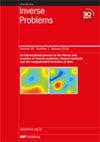On mathematical problems of two-coefficient inverse problems of ultrasonic tomography
IF 2
2区 数学
Q1 MATHEMATICS, APPLIED
引用次数: 0
Abstract
This paper proves the theorem of uniqueness for the solution of a coefficient inverse problem for the wave equation in (with two unknown coefficients: speed of sound and absorption. The original nonlinear coefficient inverse problem is reduced to an equivalent system of two uniquely solvable linear integral equations of the first kind with respect to the sound speed and absorption coefficients. Estimates are made, substantiating the multistage method for two unknown coefficients. These estimates show that given sufficiently low frequencies and small inhomogeneities, the residual functional for the nonlinear inverse problem approaches a convex one. This solution method for nonlinear coefficient inverse problems is not linked to the limit approach as frequency tends to zero, but assumes solving the inverse problem using sufficiently low, but not zero, frequencies at the first stage. For small inhomogeneities that are typical, for instance, for medical tasks, carrying out real experiments at such frequencies does not present major difficulties. The capabilities of the method are demonstrated on a model inverse problem with unknown sound speed and absorption coefficients. The method effectively solves the nonlinear problem with parameter values typical for tomographic diagnostics of soft tissues in medicine. A resolution of approximately 2 mm was achieved using an average sounding pulse wavelength of 5 mm.论超声波断层扫描双系数逆问题的数学问题
本文证明了(含两个未知系数:声速和吸声系数)中波方程系数逆问题解的唯一性定理。原来的非线性系数反问题被简化为关于声速和吸声系数的两个唯一可解的第一类线性积分方程的等价系统。对两个未知系数进行了估算,证实了多级方法的正确性。这些估算结果表明,在频率足够低、不均匀度足够小的情况下,非线性逆问题的残差函数接近凸函数。这种非线性系数逆问题的求解方法与频率趋于零时的极限方法无关,而是假设在第一阶段使用足够低但非零的频率求解逆问题。对于典型的小非均质性,例如医疗任务,在这种频率下进行实际试验并不存在重大困难。该方法在一个具有未知声速和吸收系数的逆问题模型上演示了其能力。该方法有效地解决了医学软组织断层扫描诊断中典型参数值的非线性问题。平均探测脉冲波长为 5 毫米,分辨率约为 2 毫米。
本文章由计算机程序翻译,如有差异,请以英文原文为准。
求助全文
约1分钟内获得全文
求助全文
来源期刊

Inverse Problems
数学-物理:数学物理
CiteScore
4.40
自引率
14.30%
发文量
115
审稿时长
2.3 months
期刊介绍:
An interdisciplinary journal combining mathematical and experimental papers on inverse problems with theoretical, numerical and practical approaches to their solution.
As well as applied mathematicians, physical scientists and engineers, the readership includes those working in geophysics, radar, optics, biology, acoustics, communication theory, signal processing and imaging, among others.
The emphasis is on publishing original contributions to methods of solving mathematical, physical and applied problems. To be publishable in this journal, papers must meet the highest standards of scientific quality, contain significant and original new science and should present substantial advancement in the field. Due to the broad scope of the journal, we require that authors provide sufficient introductory material to appeal to the wide readership and that articles which are not explicitly applied include a discussion of possible applications.
 求助内容:
求助内容: 应助结果提醒方式:
应助结果提醒方式:


